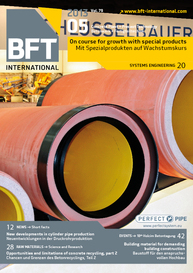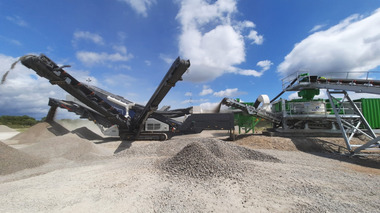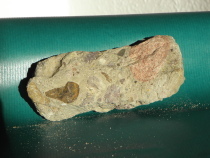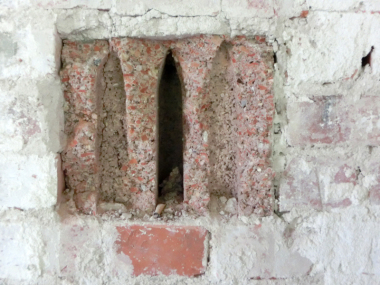Opportunities and limitations
of concrete recycling
In the future, concrete production could increasingly rely on the use of recycled aggregates (see BFT International 04/2013, pp. 78). Part 2 of this article deals with concrete durability and the modeling of recycled-aggregate
concrete.
Unlike concrete based on natural aggregates, recycled-aggregate concrete contains two types of cement paste: the “new” paste creating concrete strength and the “old” paste whose parameters – such as its composition, water/cement ratio and degree of carbonation – are unknown. In addition, such concretes contain the “old” aggregates whose origin and properties are usually unknown, too. Both the components of recycled aggregates and the new cement paste and new aggregates may comprise compounds that may become involved in deleterious chemical reactions. Furthermore, the recycled aggregates cause an increase in porosity, thus facilitating the transport of moisture, which is required for all types of reactions.
Compared to natural-aggregate concrete, recycled-aggregate concrete generally involves a significantly larger number of factors that may impact durability. Although this situation is not necessarily associated with an adverse effect on durability, it presents greater difficulties when it comes to producing a durable concrete exactly to specification. Starting from the premise that the production and use of concretes containing recycled aggregates should not reveal any differences compared to conventional concrete, the use of recycled aggregates in Germany is restricted to certain strength, exposure and moisture classes. The DAfStb Code of Practice [48] specifies the use of recycled aggregates whose quality conforms to DIN 4226-100 [46] or to its successor standard [47]. According to this code of practice, coarse recycled aggregates of type 1 (concrete chippings) and of type 2 (chippings from demolished structures) may be used for producing concretes up to the C30/37 strength class.
Durability and carbonation
Recycled sand usually contains a high amount of cement paste and other, more easily crushable constituents with lower bulk densities and strengths, and is thus excluded from being used in concrete production. The permissible share of coarse recycled aggregates in the total aggregate decreases in line with the magnitude of in-service stresses and actions. Thus the highest ratios of 45 vol.-% (type 1) and 35 vol.-% (type 2) may be used under the conditions specified in class WO/XC1, which are usually relevant to structural components in interiors. The lower shares of 35 and 25 vol.-% apply to concretes that are moist on frequent occasions or during extended periods of use and are exposed to freeze/thaw cycles or minor chemical attacks, as well as to concretes with high water penetration resistance.
This pragmatic approach takes account of the fact that the amount of conclusive and consistent evidence regarding the durability of recycled-aggregate concretes is still scarce. For example, the findings cited in the literature with respect to carbonation reveal significant differences. Both unchanged conditions and greater carbonation depths were measured. Two examples taken from the literature [49] [43] should illustrate this situation:
Figure 12 shows the carbonation depth of recycled-aggregate concretes containing coarse and, to a certain extent, also fine recycled aggregates in comparison to concrete containing natural aggregates. The recycled aggregates were produced from concretes in various strength classes at an age of three months.
Figure 13 shows the carbonation depth of concretes containing recycled aggregates that were taken from a demolished canal lock.
The carbonation depth of the concrete that contains the early-age recycled aggregates with defined parameters does not differ from the reference concrete. In contrast, the carbonation depth of the concrete containing the aggregates from the demolished lock is significantly greater than that of the reference concrete.
When trying to explain these differences, the factors that influence carbonation depth can be considered. In simplified terms, the carbonation depth of recycled-aggregate concrete is affected by two counteracting factors: the introduction of further constituents capable of carbonation slows down the process while the additional capillary porosity caused by the old cement paste accelerates carbonation. This assumption explains the inconsistent results, permitting the conclusion that the parameters previously used to characterize recycled aggregates with respect to carbonation are insufficient because the cement paste content and its phase composition are not determined. Appropriate substitute parameters that are easy to determine would have to be identified to arrive at these additional findings.
Freeze/thaw resistance
As regards freeze/thaw resistance, there is agreement in the literature that recycled aggregates usually exhibit a lower freeze/thaw resistance than natural aggregates whereas concretes containing such recycled aggregates are frost-resistant nonetheless.
This lower freeze/thaw resistance is attributed to the higher degree of water absorption and lower strength of the recycled-aggregate particles, which is why the particles are not capable of resisting the ice pressure occurring during freeze/thaw tests. This situation results in an increased degree of spalling.
Recycled-aggregate concretes usually exhibit a sufficient degree of freeze/thaw resistance. A number of experimental tests carried out to determine freeze/thaw resistance showed that the freeze/thaw resistance parameters of recycled-aggregate concretes were significantly better than those of the reference concretes containing natural aggregates. However, certain limitations were revealed when both coarse and fine aggregates were replaced with recycled aggregates. A significant deterioration was found for some of the concretes containing recycled sand. It is thus advisable to replace recycled sand with natural sand to produce a recycled-aggregate concrete with freeze/thaw parameters equivalent to natural-aggregate concrete.
Higher brick ratios lead to an additional improvement because they promote the formation of pores (similar to air-entraining agents), thus creating voids into which the water can expand during freezing.
Alkali-silica reaction
To date, there is only little evidence in the literature regarding the reactivity of recycled aggregates in the context of the alkali-silica reaction (ASR). There is no clear answer to the question of whether recycled aggregates taken from concretes that contained ASR-reactive aggregates continue to exhibit reactive potentials that may cause damage to the recycled-aggregate concrete. For instance, the example from [50] shown in Figure 14 illustrates the strains of the original concrete produced with alkali-reactive aggregates. These strains were measured on concrete prisms of 40 x 40 x 285 mm in size. The diagram also shows the strains of the concrete that contained recycled aggregates taken from the reprocessed original concrete. The original concrete had an age of twelve years at the time of its reprocessing and reuse. Measurements revealed virtually no differences. The reactivity of the aggregates used in these tests continues to cause considerable strains in second-generation concretes. The measured strains are lower if the prisms are produced from fine recycled aggregates, but they still exceed the permissible threshold.
In the second example taken from [51], the recycled-aggregate concrete produced from an old, severely damaged road pavement hardly revealed any strains. This permits the conclusion that its reactivity was fully utilized. Another recycled-aggregate concrete was produced using concrete from a demolished structure whose prior history was not known. This concrete reveals more considerable strains.
Even though we are unable to arrive at a clear conclusion, concretes damaged by an ASR should preventively be excluded from use as recycled materials. Under real-life conditions, however, it is virtually impossible to determine whether the produced recycled aggregate contains alkali-reactive aggregates if its origin can no longer be ascertained. For this reason, the alkali guideline applicable in Germany prescribes that recycled aggregates be tested to identify any alkali-reactive constituents that may originate from the primary mineral aggregate, and to determine their alkali content.
Sulfate attack
Both the sulfate content and the amount of gypsum particles contained in recycled aggregates are strictly limited to prevent expansive sulfate attack. Despite this precaution, the presence of gypsum particles cannot be excluded completely because the tested amounts are usually not large enough to ensure compliance with the prescribed low thresholds with sufficient statistical certainty.
At the fresh-concrete stage, gypsum may interfere with the hardening process. When the recycled aggregate concrete has hardened, the gypsum may react with the hydration products of both the new and the old cement paste. For example, the calcium aluminate monosulfate may be converted to trisulfate, which is associated with a 2.3 fold volume increase. Also, calcium aluminate hydrate may be converted to ettringite, resulting in a 4.8 fold volume increase. Both reactions lead to damage to the concrete by expansion phenomena.
4 Approaches to modeling recycled-aggregate concrete
In the case of standard concrete, we can apply a simplified approach assuming that its strength depends on its main constituents, i.e. aggregates and cement paste, and on the interfacial area that is formed between them. The number of influential parameters is significantly larger for concrete containing recycled aggregates. A distinction can be made between influences of the recycled aggregates that stem from the original aggregates and the old cement paste, which causes them to form clusters or covers their surface, and influences of the new aggregates and of the active cement paste that triggers concrete hardening. The number of interfacial areas increases to six if we assume that such areas are formed between all of the components.
Jianzhuang Xiao carried out an FEM simulation of chloride diffusion [52] and thus made one of the first contributions toward establishing a multi-phase material model of a recycled-aggregate concrete. In this model, the recycled-aggregate concrete is considered to be a five-phase composite. The old and the new interfacial areas represent the so-called “interphases”. The old and the new mortar and the original aggregates form the “continuous phases”. The outcomes of the FEM simulation are highly consistent with the results arrived at in the theoretical calculation of chloride diffusion. These findings were not compared with measured values.
Characterization of aggregates
To date, the mechanical properties of recycled-aggregate concretes have been primarily modeled on the basis of statistical methods [53] [54] [55]. No phenomenological models were described that were derived from the interactions of the individual composite constituents contained in the recycled-aggregate concrete. A stepwise approach is necessary to first develop an understanding of these interactions:
In the first step, the recycled aggregates must be clearly characterized.
In the second step, correlations between the characteristic features of the recycled aggregates and the mechanical properties of the concretes produced with these aggregates need to be identified.
In addition, the influence of the new aggregates and of the active cement paste causing concrete hardening on these correlations needs to be considered.
Cement paste content and physical characteristics
The characterization of recycled aggregates as the first building block of a model is derived from the fact that these aggregates consist of the original aggregate and the cement paste (see Fig. 3) if they are extracted from old concrete in a conventional reprocessing step. Neglecting the interfacial area, these aggregates can be considered to be a binary system in which natural aggregates and cement paste constitute the two endpoints of a mixing series. The physical parameters of the endpoints can be used to derive a simplified phase diagram for the relevant characteristics by calculating the bulk and true densities across the mixing series, applying the values for pure natural aggregates and pure cement paste to Equation 1.
ρRC = ρZS · ρGK
αZS · ρGK · αGK · ρZS
Figure 15 shows a comparison of the calculated changes in bulk and true densities and overall porosity with the corresponding measured values, which were determined for technically reprocessed recycled aggregates, recycled aggregates from concretes with defined parameters and model concretes with graded cement paste ratios. The measured values largely support the curve derived from the mix calculation.
The cement paste ratios of recycled building materials produced from reprocessed concrete rubble range from about 10 to 40 m.-%. These findings alone result in a wide range of physical characteristics, i.e. 2.4 to 2.1 g/cm³ for bulk density and 0.6 to 9.8% for water absorption.
In the literature, recycled aggregates are described as composites consisting of mortar (which comprises the cement paste and the fine aggregate) and coarse aggregates. The measurements performed by Abbas [25] revealed mortar ratios ranging from 21 to 43 m.-%. De Juan [24] states mortar contents between 33 and 55 m.-% for the 4-8 mm aggregate size and between 23 and 44 m.-% for the 8-16 mm size. According to the definition, the mortar ratios should be significantly higher than the cement paste ratios, as demonstrated by the values established by de Juan. This author also proved that important physical characteristics of recycled aggregates correlate with the mortar ratio.
Mechanical properties of concretes
The second building block of the modeling exercise is to identify a correlation between the characteristics of the recycled aggregates and the mechanical properties of the concretes containing them. Influential parameters include the amount of old cement paste but also the type of the original aggregate and the strength of the concrete from which the recycled aggregates were produced.
The findings established by Ajdukiewicz [44] and de Pauw [58] were analyzed to determine the way in which the strength or the modulus of elasticity of the “parent” concrete influence the corresponding characteristics of the recycled-aggregate concrete. Figure 16 summarizes the influence of strength in the diagram on the left-hand side. The strength values of the original concretes ranged from 20 to 70 MPa. The derived recycled-aggregate concretes revealed strengths ranging from 30 to 50 MPa. There is consistent evidence that the strength of the parent concrete has a rather moderate effect on the strength of the derived recycled-aggregate concrete. It was found that recycled-aggregate concrete derived from a low-strength concrete can achieve or even exceed the strength of the original concrete. This may be due to the fact that the crushing process releases a major portion of the aggregate particles from their weak bond that includes only a low amount of cement paste. If, as in the present case, only the coarse portion of the recycled aggregates is used for producing the recycled-aggregate concrete, only a minor amount of old cement paste is introduced that may cause a decrease in strength. If a higher-strength concrete is used as the basis to produce the recycled aggregates, a higher amount of cement paste will remain linked to the aggregate after reprocessing and is subsequently introduced into the concrete, which results in a decrease in strength compared to the parent concrete.
Modulus of elasticity
The modulus of elasticity of the parent and recycled-aggregate concrete also reveals a certain attenuation of the influence but the original concrete is not “overtaken” by the recycled-aggregate concrete. However, the certainty of this conclusion is weakened because only a few measured values were available.
Tests were carried out on three levels to determine the influence of the old cement paste content on both strength and modulus of elasticity:
First, a simplified approach was used to replicate recycled aggregates as mixtures of natural aggregates and pure cement paste. This method is associated with a high degree of abstraction because there is no connection between the two constituents of the composite.
Second, two coarse recycled aggregates were used whose cement paste ratios differed from each other. This method resulted in the introduction of a varying amount of cement paste whereas the recycled-aggregate ratio remained identical.
Third, crushed sand was used as a fine component containing cement paste, and added in varying amounts.
Both the modeled and the actual recycled aggregates were used to produce concretes with graded coarse aggregate ratios.
The results shown in Figure 17 demonstrate that the characteristics of the secondary concretes consisting of recycled aggregates with varying cement paste ratios are relatively close to each other. These considerations permit the conclusion that the cement paste content appears to be one of the main influential parameters. The concretes that contained pure cement paste and the concretes produced with fine recycled aggregates revealed considerable differences, which may have been caused by interfacial phenomena. The concrete containing pure cement paste was lacking the interfacial area between the original aggregate and the old cement paste. The concrete produced from fine recycled aggregates exhibited a particularly strong interfacial area between the recycled aggregates and the new cement paste.
New aggregate and active cement paste
In the third step of phenomenological modeling, the influences of secondary concrete production need to be integrated as a further building block of the model, relying on correlations such as the generally established water/cement ratio principle.
If required, the proposed building blocks and their linkage enable better estimates of the mechanical properties. The considerations described above are still insufficient with respect to durability. For example, the phase diagram shown in Figure 15 only includes the most important physical characteristics. Furthermore, the endpoints of the mixing series differ in their chemical and mineralogical compositions and in their reactivity. Natural aggregates that meet the specifications usually consist of silica and feldspar, or of calcite. They are inert. The cement paste present in recycled aggregates contains portlandite, C-S-H phases and calcium sulfoaluminates; it may also contain unhydrated cement particles and other phases. These constituents may react with water, carbon dioxide, sulfate etc. Any appropriate durability assessment thus requires a thorough description of the chemical composition.
5 The future of recycling
Recycling as the re-introduction of used products and materials into the material cycle is not a phenomenon of our times. Rather, the recourse to older materials can be demonstrated for most preserved buildings or structures – from Antiquity to the Middle Ages. The significance of the recycling of building materials decreased only when the achievements of the industrial revolution enabled the large-scale production of building materials.
It is quite difficult to determine the point in time when “modern” building materials recycling began. We are currently seeing a transition: from mere demolition to dismantling and disassembly, from landfill to the reuse of building materials. Structures that are no longer required or that no longer meet the needs of their users or applicable technical specifications and standards are dismantled.
Today, we can at least say that the demolition, dismantling and reprocessing steps have become a necessary and accepted part of construction activity. Yet there are still reservations when it comes to the possible uses of recycled building materials.
Cycle for coarse aggregate sizes
Reprocessed concrete rubble may be reused for concrete production provided that compliance with applicable standards and regulations is ensured. Even if only such areas of use are envisaged for precautionary reasons that have no critical influence on durability, the total amount of coarse recycled aggregates from concrete rubble could be used for producing new concrete. While available recycled aggregates amount to approx. 20 million tonnes, the consumption of natural aggregates for concrete production is about ten times higher. This means that a closed cycle for the coarse portions of reprocessed concrete rubble would be possible.
To date, the fine sizes produced during the reprocessing of concrete rubble have been excluded from this cycle. However, these fines might be used as an additive in concrete production provided they are ground to the fineness of cement. According to own investigations, this use would result in cement savings and improvements in the concrete performance characteristics [62].
The above considerations exclusively apply to pure-grade concrete. In contrast, concrete rubble that stems from the demolition of structures usually contains other, secondary constituents, which need to be removed prior to its use as a recycled aggregate. Other sectors of the recycling industry, such as plastics and glass, rely on sensor-based classifying processes that detect the individual particles of a bulk solid and separate them into various groups of materials. It would be necessary to develop such methods for concrete recycling, too.
Deriving more comprehensive quality criteria
The fact that recycled aggregates are composites consisting of cement paste and natural aggregates must be taken into account to gain a more thorough understanding of recycled-aggregate concretes. If these recycled aggregates are used for the production of new concrete, the secondary concrete will have a higher cement paste ratio. Its mechanical properties thus exhibit systematic alterations and more marked variations. The higher cement paste ratio also plays a key role with respect to durability because it leads to an increase in porosity. Water is required as a partner for most reactions that compromise durability; it may penetrate more easily into the concrete.
Other important influential parameters include the chemical condition of the old cement paste and of the original aggregates. For example, concrete of a very old age or recycled aggregates stored for a long period may have undergone complete carbonation, which is why they no longer contain hydration products. It is equally difficult to determine the reactivity of the original aggregates in an alkali-silica reaction.
Quality criteria need to be developed in a more thorough and comprehensive manner since our knowledge of the characteristics of recycled concrete aggregates and concretes produced with them continues to be insufficient. Statistical analyses are even more important than for natural-aggregate concrete.
The future of recycling is closely linked to current trends in the development of building materials. Concrete is a commodity building material that is relatively easy to recycle in its conventional composition. Future developments, however, may challenge this good recyclability. Relevant examples include the joining of concrete with other components to form composite elements, or certain new mix designs. In these cases, solutions are required that no longer rely on the material characteristics of concrete but utilize its potential as a raw material instead.

![12Carbonation depth of concretes containing defined recycled aggregates produced for the tests [49]. Ra: recycled aggregates from a three-month old concrete of strength class B 15 with w/c = 0.68; Rb: recycled aggregates from a three-month old concrete of strength class B 45 with w/c = 0.48](https://www.bft-international.com/imgs/5/4/7/0/2/1/tok_ddc15c63cfc9942ec646657d3bc9eb34/w300_h200_x297_y421_b6b2ece566f3cfdf.jpg)
![13Carbonation depth of concretes containing recycled aggregates produced from concrete rubble [43]. 01: reference; 03: CEM I, 75 m.-% RC 2/32 mm; 05: CEM III/A, 75 m.-% RC 2/32 mm; 06: CEM I, 75 m.-% RC 2/32 mm + 12.5 m.-% RC 0/2 mm; 08: CEM III/A, 75 m.-% RC 2/32 mm + 12.5 m.-% RC 0/2 mm; 09: CEM I, 75 m.-% RC 2/32 mm + 25 m.-% RC 0/2 mm](https://www.bft-international.com/imgs/5/4/7/0/2/1/tok_5867a9f5e0a0d2e531a74820ad99fb12/w300_h200_x400_y174_86fb50f09d782d91.jpg)
![14Expansion of concrete prisms containing recycled aggregates produced from concretes that contained alkali-reactive aggregates [50]. Aggregates; spratt: alkali-reactive siliceous lime; coarse RCA: coarse recycled aggregates from concretes containing alkali-reactive aggregates; fine RCA: fine recycled aggregates from concretes containing alkali-reactive aggregates](https://www.bft-international.com/imgs/5/4/7/0/2/1/tok_78578658d13eccfa79c90dad069f2c60/w300_h200_x297_y421_f3c3e723f1bdf2bb.jpg)
![15Phase diagram for recycled aggregates (data for technically reprocessed recycled aggregates [56], recycled coarse aggregates from concretes with defined parameters [57], model concretes [28])](https://www.bft-international.com/imgs/5/4/7/0/2/1/tok_b7846babd7f3f1c14621cf248e273ab0/w300_h200_x297_y421_cc620731229d4a7d.jpg)
![16Dependence of mechanical properties of the recycled-aggregate concrete on the characteristics of the original concrete [44] [58]](https://www.bft-international.com/imgs/5/4/7/0/2/1/tok_2f259b48644a28257d8435862d863863/w300_h200_x400_y165_488d966c9cc2c385.jpg)
![17Dependence of relative compressive strength and modulus of elasticity of recycled-aggregate concretes on the amount of old cement paste introduced into the concrete mix [28] [27] [59] [60]](https://www.bft-international.com/imgs/5/4/7/0/2/1/tok_c7586de1142634a28c77bb7b918e06ca/w300_h200_x400_y153_5423d1c89ebfdeaa.jpg)





